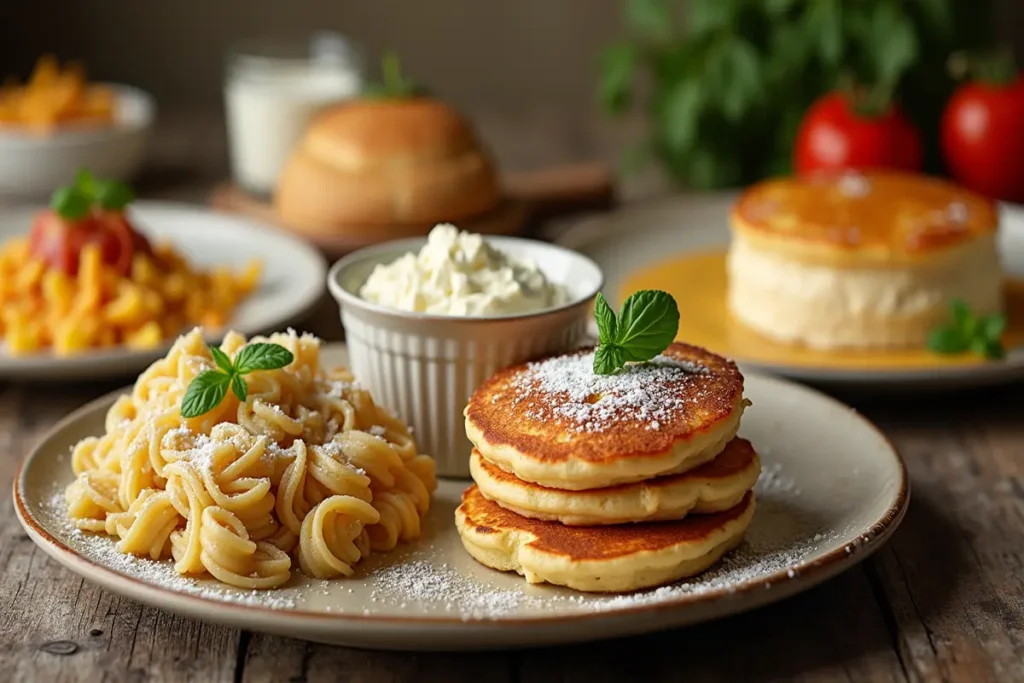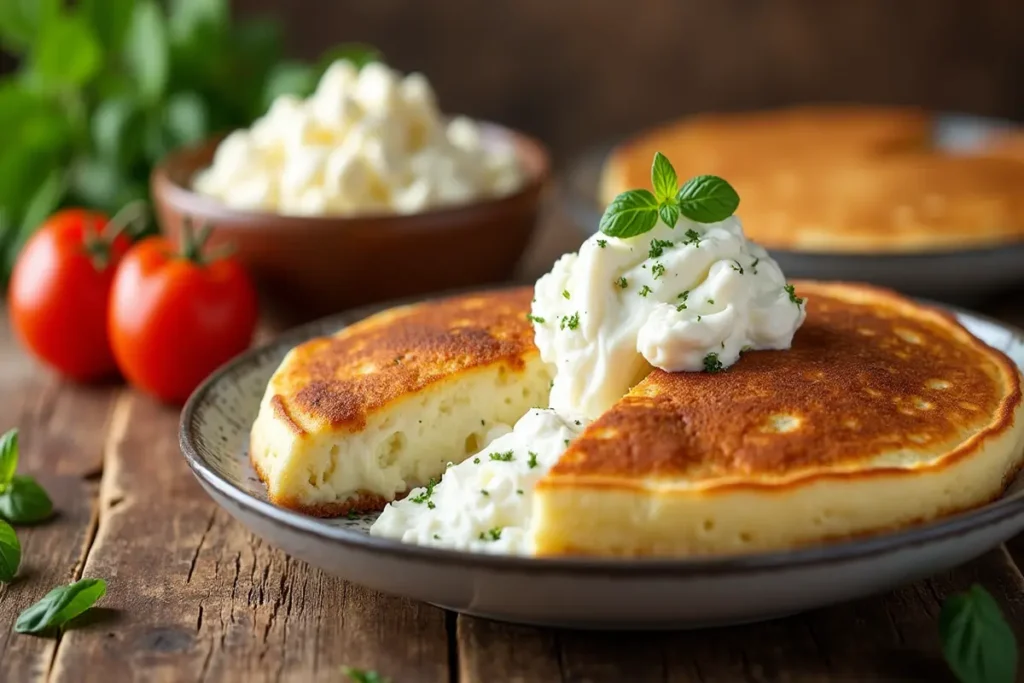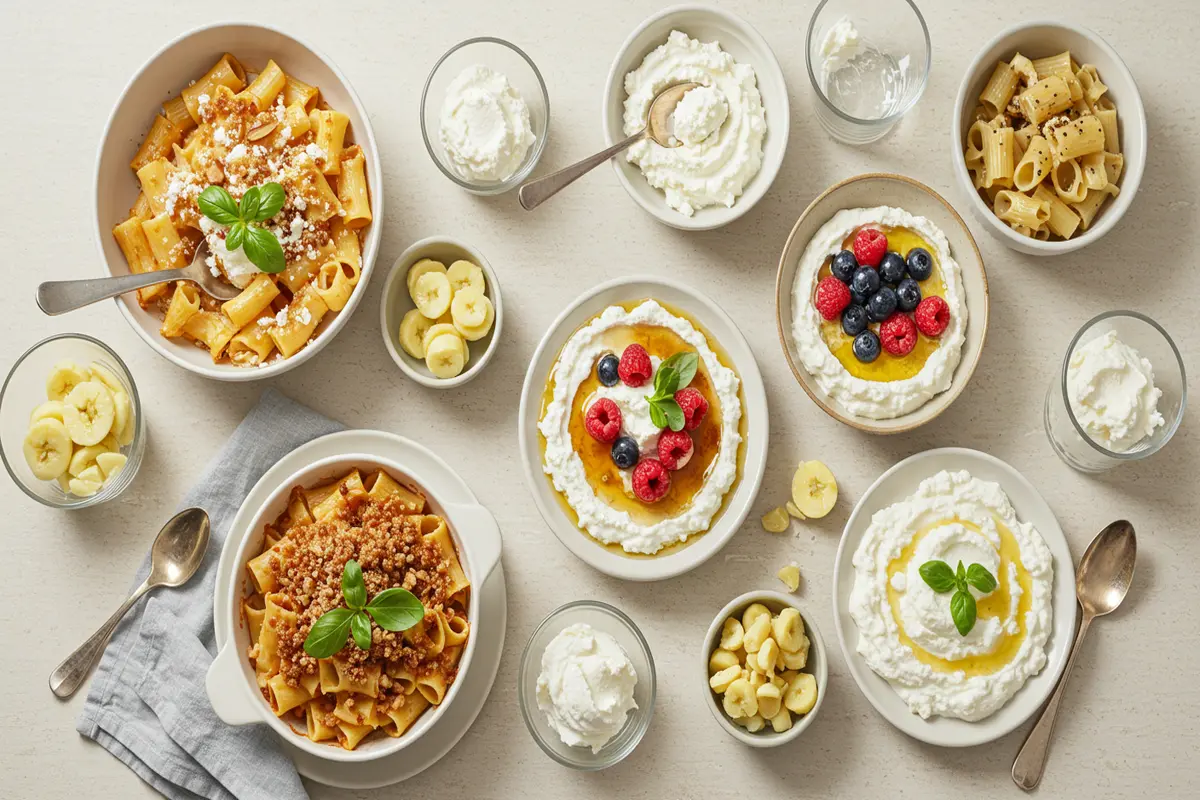Introduction: Unleashing the Versatility of Ricotta
Ricotta cheese, with its creamy texture and mild flavor, is incredibly versatile. Indeed, many home cooks might wonder how to use a lot of ricotta effectively. Therefore, this article will explore various ways to utilize this dairy delight. Moreover, from savory dishes to sweet treats, we’ll show you how to make the most of it. Consequently, you’ll find new and exciting uses for it.
Table of Contents
Exploring Savory Dishes
Classic Pasta Dishes: Utilizing Ricotta in Traditional Ways
One popular way to use ricotta is in pasta. Therefore, consider stuffed pasta like cannelloni or manicotti. Additionally, it provides a creamy filling that complements the pasta beautifully. Furthermore, you can use it as a base for sauces. For example, add it to a marinara sauce for a richer flavor. Moreover, it can be blended with herbs to create a simple yet delicious topping for gnocchi. In effect, it enhances the texture and taste of pasta dishes. Ultimately, it’s a versatile addition to many Italian classics.
Baking with Ricotta: How to Incorporate a Lot of Ricotta in Baked Goods
Ricotta also excels in baked dishes. For example, consider lasagna. Consequently, it is a staple ingredient for adding a creamy layer between pasta and sauce. Moreover, you can make a decadent pie with a flaky crust. In addition, it can be incorporated into baked frittatas and quiches. Therefore, its creamy texture binds the ingredients together perfectly. Furthermore, its mild flavor allows other ingredients to shine. In baking, it’s a great way to enjoy its texture.
Savory Pancakes and Fritters: Unique Ways of Using Ricotta
Moreover, you can incorporate it into savory pancakes and fritters. For instance, blend it into your pancake batter for a fluffy texture. Furthermore, it can also be added to vegetable fritters for extra moisture. As a result, the cheese lends a subtle richness to each bite. Specifically, it can transform these breakfast or brunch staples. Indeed, it’s an excellent way to use up leftovers.
Ricotta Dips and Spreads: Exploring DifferentUsage
Another effective way involves creamy dips and spreads. Comparatively, it can be blended with herbs, garlic, and olive oil. In effect, this creates a light and flavorful dip. Moreover, use it as a base for spreads on toast or crackers. Consequently, it is an incredibly versatile option. Furthermore, this is a simple way to enjoy its fresh taste. Ultimately, these dips and spreads are easy to make and impressive to serve.
Substituting with Ricotta: Ricotta as a Cream Cheese Alternative
Ricotta is an excellent substitute for cream cheese. Therefore, try it in dips or as a spread on a bagel. Likewise, in place of cream cheese can add a lighter touch. Furthermore, it’s a healthy alternative without sacrificing flavor. For example, use it in cheesecake recipes for a less dense outcome. Also, it can be a key ingredient in pasta fillings. Indeed, its versatility makes it a great swap in several recipes.
Sweet Ricotta Creations


Ricotta in Desserts: Sweet Applications and Ricotta Ideas
Ricotta isn’t just for savory dishes. Indeed, it’s also a fantastic ingredient for desserts. For example, use it to make a classic Italian cake. Similarly, blend it with sugar and vanilla for a simple and sweet treat. Additionally, it can be used as a filling for pastries and tarts. Moreover, these sweet creations are both comforting and satisfying. Likewise, these desserts highlight its delicate flavor.
Sweet Ricotta Fillings: How to Maximize Ricotta in Pastries
Furthermore, explore ways in sweet fillings. Specifically, consider cannoli. Consequently, a traditional cannoli filling is made with sweetened cheese. In addition, it can be used in fruit tarts and crepes. Accordingly, it adds a creamy texture and subtle tang. Moreover, you can add different extracts for more depth. Specifically, its versatility makes it the perfect base for many fillings.
Sweet Ricotta in Breakfast: Adding Ricotta to Pancakes and Waffles
Additionally, you can use it in sweet pancakes and waffles. For example, add it to the batter for extra moisture and a fluffy texture. In addition, the mild flavor of complements the sweetness of maple syrup and fruit. Moreover, this way will give your breakfast treats a delightful richness. Specifically, these are simple yet delicious changes to classic breakfast dishes. Therefore, try it in your next pancake or waffle batch.
Ricotta Sweet Dips: Creamy Ricotta Based Spreads and Accompaniments
Sweet dips and spreads are a delightful alternative as well. Likewise, can be explored by making a sweet, creamy dip. Blend it with honey, cinnamon, and a dash of vanilla. Furthermore, serve this dip with fruit or biscotti. Moreover, use it as a spread on toast. Specifically, it’s an easy dessert or afternoon snack. Also, it’s a wonderful way to enjoy its versatility.
Ricotta Frosting: A Lighter Option for Your Cakes
Moreover, it can also be used as a lighter alternative to traditional frosting. Blend it until smooth and mix with powdered sugar. Then, add your favorite flavorings, such as lemon zest or vanilla extract. Ultimately, this creates a less heavy frosting for cakes and cupcakes. Indeed, this way can cut down on sweetness without sacrificing flavor. Specifically, it’s a smart substitution for frosting.
Practical Tips for Using Ricotta
Selecting Ricotta: Choosing the Best Ricotta for your Recipes
When considering, select the right type. Usually, fresh is the best option. Furthermore, look for it made from whole milk for the richest flavor. Moreover, avoid it that is too watery. Specifically, the quality can impact your final dish. Therefore, choosing the right type is crucial for the best results.
Storing Fresh Ricotta: Ensuring Proper Storage and Freshness
Proper storage is key to maintaining freshness. Accordingly, store opened in an airtight container in the refrigerator. Similarly, use it within a few days for best results. Therefore, avoiding exposure to air will help keep it fresh. Further, if liquid separates, simply drain it off before use. Indeed, proper storage extends the lifespan of it.
Ricotta in Cooking: Tips and Tricks for Using Ricotta in Recipes
For optimal results, incorporate it gently into recipes. Furthermore, when using it in baking, avoid overmixing, as this can lead to a dense texture. Moreover, for fillings, use well-drained to prevent excess moisture. Additionally, don’t be afraid to experiment with different herbs and flavorings to create unique dishes. Ultimately, these tips will help you achieve the best results when cooking with it.
Homemade Ricotta: Making Ricotta at Home for Maximum Flavor
Furthermore, for a truly rewarding experience, try making at home. It involves heating milk and adding an acid, such as lemon juice or vinegar. Therefore, the milk curdles and separates from the whey. Moreover, strain the curds to produce fresh. Accordingly, homemade is incredibly fresh and has a richer flavor. Especially, this gives you a better understanding.
Leftover Ricotta: Smart Ways to Use Remaining Ricotta
Afterward, if you have leftover, don’t let it go to waste. Hence, consider making a quick dip, as we’ve previously discussed. Or, add it to scrambled eggs or frittatas for added richness. Also, you can also use it in smoothies for a creamy boost. In effect, there are countless ways to use leftover. Moreover, this ensures that none of this versatile cheese goes to waste.
Frequently Asked Questions (FAQs)
Can ricotta cheese be frozen?
Yes, ricotta can be frozen. However, its texture may change slightly. Specifically, it might become grainier upon thawing. Accordingly, it’s best to use thawed in cooked dishes where texture is less critical. Therefore, freezing is a good option if you have a surplus of it. Also, use freezer-safe containers to prevent freezer burn.
What is the difference between ricotta and cottage cheese?
Ricotta and cottage cheese are both fresh cheeses, but they differ in their texture and production. For example, is made from whey, while cottage cheese is made from curd. Consequently, has a finer, creamier texture. Conversely, cottage cheese has larger, more distinct curds. Also, typically has a milder flavor.
How long does fresh ricotta last in the fridge?
Fresh typically lasts for about 3 to 5 days in the refrigerator after opening. Consequently, store it in an airtight container for best results. Furthermore, always check for any signs of spoilage before consumption. Moreover, if it develops an off-odor, it is best to discard it. Therefore, proper storage will extend its shelf life.
Can ricotta be used in place of mascarpone?
Indeed, ricotta can be used in place of mascarpone in many recipes. However, keep in mind that mascarpone is richer and has a higher fat content. Consequently, will result in a lighter dish. Likewise, use full-fat for a closer texture to mascarpone. For instance, you can use this substitution in desserts like tiramisu.
Conclusion: Enjoying the Endless Possibilities of Ricotta
In summary, how to use a lot of ricotta is a question with numerous answers. Consequently, this versatile cheese can be incorporated into a myriad of dishes. Moreover, from savory pasta and baked goods to sweet desserts and dips, it offers endless possibilities. Furthermore, by following the tips and recipes provided, you can fully explore the culinary potential of ricotta. Thus, enjoy experimenting with this delicious ingredient in your kitchen. Finally, its mild flavor and creamy texture make it a truly unique and valuable addition to any kitchen.
For more recipes

